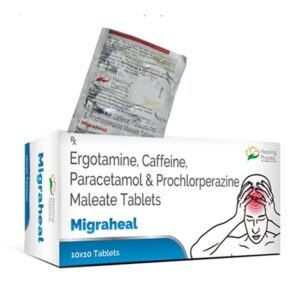PARACETAMOL (ACETAMENOPHEN) + CAFFEINE + PROCHLORPERAZINE + ERGOTAMINE
Paracetamol (acetamenophen): Paracetamol, also known as acetaminophen, is a widely used medication for pain relief and reducing fever. It is available over the counter and in prescription form.
Paracetamol is commonly used to relieve mild to moderate pain, such as headaches, toothaches, muscle aches, and menstrual cramps. It is also commonly used to reduce fever in individuals of all ages, including children.
The exact mechanism of action of paracetamol is not fully understood, but it is believed to work by inhibiting the enzymes involved in the production of prostaglandins, which are substances that play a role in pain and fever.
The recommended dose of paracetamol for adults is usually between 325 mg to 1000 mg every 4 to 6 hours, with a maximum daily dosage of 4000 mg. However, it is important to follow the specific dosage instructions provided by a healthcare professional or stated on the medication packaging. For children, the dosage is weight-based and should be determined by a doctor.
When taken at the recommended dosage, paracetamol is generally well-tolerated. However, it can cause side effects in some individuals, though they are typically mild. Common side effects include nausea, stomach upset, and skin rash. In rare cases, allergic reactions and liver damage may occur, especially with excessive doses or long-term use. It is important to seek immediate medical attention if any signs of an allergic reaction or liver damage, such as yellowing of the skin or eyes, dark urine, or persistent abdominal pain, occur.
It is worth noting that paracetamol is generally considered safe when used as directed, but it is important to avoid exceeding the maximum daily dosage and to avoid taking it in combination with other medications that may contain paracetamol to prevent accidental overdose. Always consult with a healthcare professional before starting or changing any medication regimen.
Caffeine: Caffeine is a central nervous system stimulant that is found in various beverages and food products, most commonly in coffee and tea. It is widely used to increase alertness and combat fatigue.
Mechanism of action:
Caffeine works by binding to adenosine receptors in the brain, blocking their function. Adenosine is a neurotransmitter that promotes sleepiness and relaxation. By blocking these receptors, caffeine stimulates the release of other neurotransmitters like dopamine and norepinephrine, which promote wakefulness and increase focus.
Use:
Caffeine is primarily used to combat fatigue and increase alertness. It is commonly consumed in the form of coffee, tea, energy drinks, soda, and some medications. It can also be found in certain food items such as chocolate and some medications.
Dose:
The recommended dose of caffeine varies depending on the individual and their tolerance. Generally, a moderate dose of caffeine for adults is considered to be around 200-300 mg per day, which is roughly equal to one to three cups of coffee. It is important to note that caffeine sensitivity can vary greatly among individuals, and excessive consumption can lead to adverse side effects.
Side effects:
While caffeine is generally safe in moderation, excessive consumption can lead to various side effects. These may include jitters, restlessness, increased heart rate, increased blood pressure, headache, insomnia, digestive issues, and irritability. Some individuals may also experience withdrawal symptoms if they abruptly stop consuming caffeine after regular use, such as fatigue, headaches, and mood disturbances.
It is important to consume caffeine in moderation and be aware of the individual tolerance levels and potential side effects. Pregnant women, individuals with certain medical conditions, and those taking certain medications should consult with a healthcare professional before consuming caffeine.
Prochlorperazine: Prochlorperazine is a medication primarily used to manage symptoms of nausea and vomiting, as well as to treat certain mental disorders such as schizophrenia and anxiety.
Mechanism of Action:
The exact mechanism of action of prochlorperazine is not fully understood. However, it is believed to work by blocking dopamine receptors in the brain, specifically those in the chemoreceptor trigger zone (CTZ) and the mesolimbic system. This blockade helps to reduce the activity of dopamine, a neurotransmitter associated with nausea and psychotic symptoms.
Use and Dosage:
Prochlorperazine is commonly prescribed for the treatment of nausea and vomiting associated with various conditions, including chemotherapy, surgery, and migraine. It can be taken orally, as tablets or liquid, or administered through injections. The recommended dosage may vary depending on the individual, the condition being treated, and the method of administration. It is important to follow the instructions provided by the healthcare professional or the medication label.
Side Effects:
Like any medication, prochlorperazine may cause various side effects. Common side effects include drowsiness, dizziness, blurred vision, dry mouth, constipation, and urinary retention. These side effects are generally mild and tend to improve over time. However, if they become bothersome or persist, it is important to consult with a healthcare provider. Rare but potentially serious side effects may include tardive dyskinesia (involuntary repetitive movements), neuroleptic malignant syndrome (a potentially life-threatening condition characterized by fever, muscle rigidity, and altered mental status), and low blood pressure.
It is essential to discuss the risks and benefits of using prochlorperazine with a healthcare provider before starting the medication. Individuals with certain medical conditions, such as Parkinson’s disease, liver or kidney disease, or a history of seizures, should use prochlorperazine with caution and under close medical supervision. Additionally, prochlorperazine may interact with other medications, so it is crucial to inform the healthcare provider about any other drugs being taken.
Ergotamine: Ergotamine is a medication primarily used to treat migraines and cluster headaches. It belongs to a class of drugs called ergot alkaloids, which are derived from a fungus known as Claviceps purpurea.
The exact mechanism by which ergotamine works is not fully understood. It is thought to constrict the blood vessels in the brain and inhibit the release of inflammatory substances, thereby reducing the severity of migraines and cluster headaches.
Ergotamine is typically taken as a tablet or suppository, and the dose can vary depending on the specific formulation and severity of symptoms. For migraines, the usual dose is 1-2 mg at the onset of the headache, with additional doses of 1 mg if needed, up to a maximum of 6 mg per day. For cluster headaches, the usual dose is 2 mg at the onset of the headache, with additional doses of 1 mg if needed, up to a maximum of 6 mg per day.
Common side effects of ergotamine include nausea, vomiting, abdominal pain, dizziness, and muscle pain or weakness. It can also cause numbness or tingling in the fingers or toes, and in rare cases, it may lead to gangrene if blood circulation is severely restricted. Other serious side effects can include chest pain, rapid or irregular heartbeat, severe allergic reactions, or signs of overdose such as confusion, hallucinations, seizures, or loss of consciousness.
Due to its potential for serious side effects and drug interactions, ergotamine should not be used concurrently with certain medications, such as ritonavir, ketoconazole, and clarithromycin. It is important to consult with a healthcare professional before starting ergotamine to ensure it is safe and appropriate for use.


